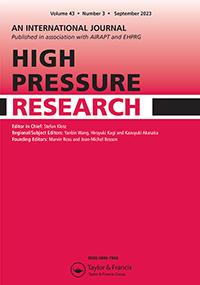Special collection of free articles available from High Pressure Research Vol. 41-43
Recently, a selection of research articles which appeared in High Pressure Research has been made freely accessible by Taylor & Francis for a generous period of 3 months. Among the array of noteworthy contributions, is a recent paper that introduces hpMCA, a newly introduced software program at HPCAT. The software is designed to support the energy-dispersive X-ray diffraction (EDXD) data collection and analysis, with a focus on the unique demands of high-pressure and high-temperature experiments.
While angle-dispersive X-ray diffraction (ADXD) remains the predominant method for synchrotron X-ray experiments, EDXD holds a distinct ability to mitigate stray scattering in complex environments and is the preferred method for HPCAT experiments involving the large volume press. However, experimenters working with EDXD have long faced a lack of user-friendly software options tailored for real-time high-pressure data visualization and processing.
hpMCA was introduced as the solution to this challenge, offering compatibility with diverse energy dispersive detector hardware configurations, real-time data visualization, updated calibration capabilities, and comprehensive support for multi-element detectors. Furthermore, hpMCA includes additional functionalities for high-pressure and high-temperature experiments. These include crystal phase identification, real-time peak fitting, precise crystal lattice refinement, equation-of-state-driven pressure determination, and an array of tools for comprehensive analysis and rescaling of multi-dimensional EDXD data, even for combined ADXD and EDXD datasets.

Figure 1. Lattice refinement window. The left side of the window displays the ROIs corresponding to the observed XRD peaks, hkl, (dobs) and calculated (dcalc) values, as well as the differences between the observed and calculated values (Δd). The output on the right side shows the direct cell parameters and esd's for gold (Au), computed V, V/V0, and P. The particular data was measured for Au at ambient P and T so the V/V0 results in 1 and the P calculation results in 0 GPa.
Considering the increasing data acquisition rates enabled by advanced detectors, such as the Germanium strip detector (GSD), hpMCA's capacity to handle substantial data volumes and provide real-time analytical capabilities promises to revolutionize the analysis of physical and chemical transformations within experimental samples during high-pressure experiments. This new capability, ranging from monitoring phase transitions to chemical reactions and material melting phenomena, places HPCAT at the forefront with respect to efficiency and precision of high-pressure and high-temperature synchrotron EDXD capabilities.

Figure 2. Intensity image plots showing multi-spectral data sets. (a) Raw multi-element detector data collected from a Co57Cd109 standard. The image is showing stacked spectra collected using a 192-element GSD. (b) Stacked spectra from (a), aligned with respect to photon E. Several strong XRF lines can be identified, from left to right: Ag kα (22.104 keV), Ag kβ (24.987 keV), Cd109γ3 (88.035 keV), and Co57 γ2 (122.061 keV). (c) 2θ-resolved EDXD from Au collected using the 192-element GSD, covering a 2θ range between 6.14∘ and 10.27∘. (d) Sequentially collected 2θ-resolved data set from Figure 8, displayed with the horizontal dimension interpolated in units of q(Å−1).
Access these articles for free through December 2023:
hpMCA: a Python-based graphical program for energy-dispersive X-ray diffraction data collection and analysis
R. Hrubiak & M.L. Rivers (2023) vol. 43(3) https://www.tandfonline.com/doi/full/10.1080/08957959.2023.2209731
The structure of sc16 GaP obtained at 17.5 GPa and 1400 K
B. Lavina, E. Zanardi, A. Mujica, H. Cynn, Y. Meng, J.S. Smith, M. Kong & Y. Lee (2022)
vol. 42(3) https://www.tandfonline.com/doi/full/10.1080/08957959.2022.2113874
Probing the partitioning behaviour of Xe using in situ X-ray synchrotron techniques at high P–T conditions
Qi Chen, Chrystèle Sanloup, Hélène Bureau, Igor Rzeplinski, Konstantin Glazyrin & Robert Farla (2022)
vol. 42(4) https://www.tandfonline.com/doi/full/10.1080/08957959.2022.2144290
In situ electrical resistivity and viscosity measurements of iron alloys under pressure using synchrotron X-ray radiography
A. Pommier, K. Leinenweber, H. Pirotte, T. Yu & Y. Wang (2021)
vol. 41(1) https://www.tandfonline.com/doi/full/10.1080/08957959.2020.1865343
Density and elastic properties of liquid gallium up to 10 GPa using X-ray absorption method combined with externally heated diamond anvil cell
R. Tsuruoka, Hidenori Terasaki, Seiji Kamada, Fumiya Maeda, Tadashi Kondo, Naohisa Hirao, Saori I. Kawaguchi, Iori Yamada, Satoru Urakawa & Akihiko Machida (2021) vol 41(4) https://www.tandfonline.com/doi/full/10.1080/08957959.2021.1998478

